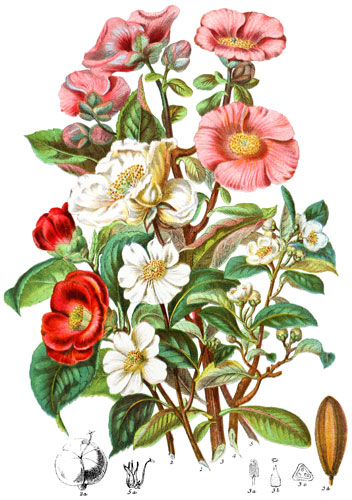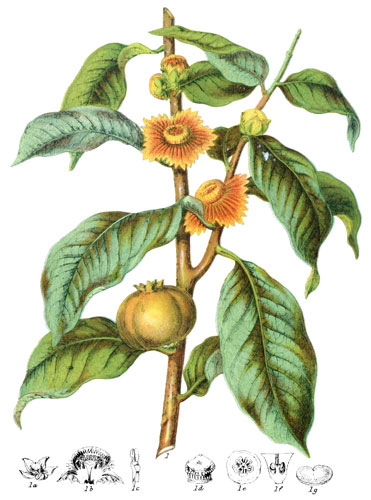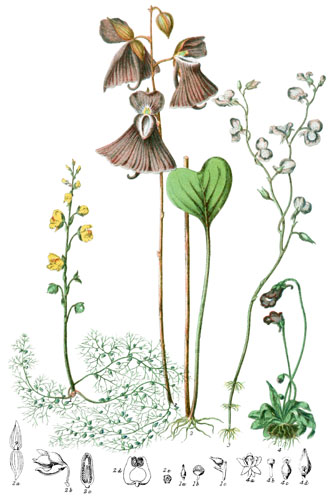Key characteristics
Succulent herbs and shrubs; the leaves are entire or pinnatifid, having no stipules; the flowers are usually collected on the top of the stem, sometimes on branching flower-stalks, on which they occasionally grow on one side only. The sepals of the calyx vary from three to twenty, and are more or less united at their base; the petals are inserted into the calyx, and are either distinct or united into one petal at the base; the stamens are inserted with the petals, and are equal to them in number, and alternate with them, or twice as many, those opposite the petals being usually shorter and later in arriving at perfection; the filaments are distinct, awl-shaped; the anthers have two cells, bursting lengthwise. The carpels are of the same number as the petals, and are placed opposite to them; one-celled, and tapering into stigmas, sometimes consolidated; sometimes there is a honey-scale at the base of each carpel. The fruit consists of several carpels opening down the seam, or the carpels are collected into one capsule of several cells opening at the back. The seeds are attached to the seam, are variable in number, and contain fleshy albumen.
The succulent nature of this tribe connects it with several others.
Acrid, stimulating, cooling, and astringent properties exist in these plants.
Select plants in this order
Not all plants listed are illustrated and not all plants illustrated are listed.
- The usual situation of these extremely succulent plants is not in moist rich soil, but, as some of the names import, on rocks, stone walls, sandy shores, and house-tops. They require in many instances very little aid from earth, moisture of atmosphere sufficing to nourish them by means of the countless invisible pores which cover the surface of the leaves. They are frequently found to possess an extraordinary power of vegetating even after being uprooted from their place of growth; Sedum Telephium, the finest of the British species in this tribe, will continue to put forth pale shoots even after being laid between paper to dry for the herbarium.
- Sedum acre (3), formerly esteemed in medicine for its acrid qualities, is usually found in a stony locality, or on a wall, adoring it with its tufts of golden flowers.
- S. linearifolia appears on the mossy stems of trees in peculiar parts of the Himalaya during the rainy season: other species are dispersed throughout the whole mountain range.
- Sempervivum tectorum (2) inhabits spots apparently the most incapable of affording nourishment, rocky ground, brick wall, or a roof of a house. It is not uncommon in this country, but does not flower so freely here as on the Continent; in rocky caves on the Lake Thun, in Switzerland, it acquires considerable size and beauty in the flowering stem. The leaves were once much valued by the poor for their supposed cooling properties.
- Sempervivum glutinosum is used by the fishermen of Madeira to render their nets tough and durable.
- The various species of Crassula are remarkable for the fleshy nature of the leaves, fringed with colourless thick hairs; C. coccinea (1) and others have brilliant red flowers, which being of long duration, are great favourites in conservatories.
- Bryophyllum calycinum (4) possesses in a striking degree the power of growth within itself; the large leaves of thick cellular substance, after being gathered from the plant and laid on the ground, will produce young plants from the notched margin. The calyx of this species is of unusual size, and tubular shape.
- Rhodiola rosea is a British species, but rare; the leaves occasionally serve as food to the poor Greenlanders.
- Kalanchoe Brasiliensis is devoid of acridity, and is esteemed by the Brazilians.
Locations
The chief mass of the plants of this Tribe is at the Cape of Good Hope, about half the known species being found there: the rest are scattered in scanty numbers over the mountains of India, in China, and Japan; a few extend northwards to Siberia and Greenland; some grow in the Canaries, some in Mexico, and in the United States; a very few in Barbary, several in the Levant, fifty-two in Europe; two have been discovered in New Holland; none in the Mauritius, or in the West Indies.
Legend
- Crassula coccinea, Scarlet Crassula. Cape of Good Hope.
- Flower, open.
- Carpel.
- Fringe of Leaf, magnified.
- Sempervivum tectorum, Common Houseleek. England.
- Carpel.
- Sedum acre, Biting Stone-crop. Britain.
- Flower.
- Section of Seed.
- Bryophyllum calysinum, Large-cupped Bryophyllum. East Indies.
Explore more
Posters
Decorate your walls with colorful detailed posters based on Elizabeth Twining’s beautiful two-volume set from 1868.
Puzzles
Challenge yourself or someone else to assemble a puzzle of all 160 botanical illustrations.





